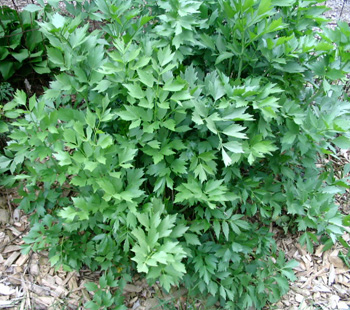Contents:
Common Names | Parts Usually Used | Plant(s) & Culture | Where Found | Medicinal Properties | Biochemical Information
Legends, Myths and Stories | Uses | Formulas or Dosages | Warning | Bibliography
Scientific Names

- Ligusticum levisticum L.
- Umbelliferae
- Umbel family
Common Names
- European lovage
- Lavose
- Sea parsley
Parts Usually Used
Rootstock, seed
Back to Top
Description of Plant(s) and Culture
The short, thick rootstock produces a round, hollow stem 3 to 6 feet high and branched near the top. The leaves vary from long-petioled and decompound, with incised, ovate leaflets, to sessite and simple near the top. The small, pale yellow flowers grow in compound umbels from June to August. The whole plant has a strong, aromatic odor.
Back to Top
Where Found
Found wild in southern Europe and Asia Minor but widely cultivated all over the continent.
Back to Top
Medicinal Properties
Carminative, emmenagogue (starts flow of menstruation), diuretic, expectorant, stimulant, stomachic, tonic
Back to Top
Biochemical Information
Essential oil with phthalidene, terpineol, carvacrol, isoveleric acid, coumarin, angelic acid, malic and benzoic acid, resin, starch, and sugar.
Back to Top
Legends, Myths and Stories
The roots of lovage add an aged-like essence to cordials, gin and bitters when properly used.
The old timers say that lovage is rubbed over the bait, any kind of fish bait, that as long as there are fish within yards of the hook, you will be pulling them in.
Back to Top
Uses
Lovage is used to treat fluid retention, bloating, gastric catarrh, stimulates appetite, and flatulence; also may be used to promote perspiration and counteract colds and flu.
Lovage is most used for its diuretic properties in cases of water retention and urinary difficulties. Skin problems will sometimes respond to a decoction added to bath water. Dropped into the eyes, it will take away the redness or dimness of them; also takes away freckles or age spots, and boils.
Back to Top
Formulas or Dosages
Rootstock can be used fresh or dried.
Infusion: 1 tsp. fresh or dried root to 1 cup water. Take 1 or 1 1/2 cups per day.
Decoction: boil 1 1/2 to 2 oz. rootstock in 4 to 6 qt. water for use as bath additive.
Back to Top
Warning
In excessive doses, lovage can cause kidney damage; this herb should not be used by those with kidney problems. Lovage promotes the onset of menstruation and should not be used by pregnant women.
Back to Top
Bibliography
![]() The Herb Book
The Herb Book, by John Lust, Bantam Books, 666 Fifth Avenue, New York, NY. copyright 1974.
 Old Ways Rediscovered
Old Ways Rediscovered, by Clarence Meyer, Meyerbooks, publisher, PO Box 427, Glenwood, Illinois 60425, published from 1954, print 1988
![]() The Complete Medicinal Herbal
The Complete Medicinal Herbal, by Penelope Ody, Dorling Kindersley, Inc, 232 Madison Avenue, New York, NY 10016, First American Edition, copyright 1993
![]() Culpeper’s Complete Herbal & English Physician: Updated With 117 Modern Herbs
Culpeper’s Complete Herbal & English Physician: Updated With 117 Modern Herbs, by Nicholas Culpeper, Meyerbooks, publisher, PO Box 427, Glenwood, Illinois 60425, 1990, (reprint of 1814)
![]() The Nature Doctor: A Manual of Traditional and Complementary Medicine
The Nature Doctor: A Manual of Traditional and Complementary Medicine, by Dr. H.C.A. Vogel; Keats Publishing, Inc., 27 Pine Street (Box 876) New Canaan, CT. 06840-0876. Copyright Verlag A. Vogel, Teufen (AR) Switzerland 1952, 1991
![]() The Herbalist Almanac
The Herbalist Almanac, by Clarence Meyer, Meyerbooks, publisher, PO Box 427, Glenwood, Illinois 60425, copyright 1988, fifth printing, 1994
Herbal Gardening, compiled by The Robison York State Herb Garden, Cornell Plantations, Matthaei Botanical Gardens of the University of Michigan, University of California Botanical Garden, Berkeley., Pantheon Books, Knopf Publishing Group, New York, 1994, first edition
![]() Planetary Herbology
Planetary Herbology, by Michael Tierra, C.A., N.D., O.M.D., Lotus Press, PO Box 325, Twin Lakes. WI 53181., Copyright 1988, published 1992
![]() American Folk Medicine
American Folk Medicine, by Clarence Meyer, Meyerbooks, publisher, PO Box 427, Glenwood, Illinois 60425, 1973
 Taber’s Cyclopedic Medical Dictionary
Taber’s Cyclopedic Medical Dictionary, 15th Edition, F. A. Davis Company, 1915 Arch Street, Philadelphia, PA 19103
![]() Webster’s New World Dictionary
Webster’s New World Dictionary, Third College Edition, Victoria Neufeldt, Editor in Chief, New World Dictionaries: A Division of Simon & Schuster, Inc., 15 Columbus Circle, New York, NY 10023
 The Rodale Herb Book: How to Use, Grow, and Buy Nature’s Miracle Plants (An Organic gardening and farming book)
The Rodale Herb Book: How to Use, Grow, and Buy Nature’s Miracle Plants (An Organic gardening and farming book), edited by William H. Hylton, Rodale Press, Inc. Emmaus, PA, 18049., 1974
